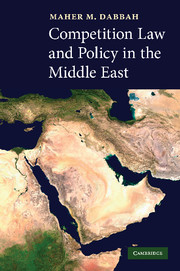Book contents
- Frontmatter
- Contents
- Preface
- List of abbreviations
- 1 Introduction
- 2 The relationship between Islam and competition law and policy
- 3 Israel: the region's oldest competition law
- 4 Turkey: a European dream from the other side of the border
- 5 The Arab Maghreb countries
- 6 Jordan's 2004 Competition Law
- 7 The Gulf States: a possible model for regional cooperation
- 8 The Arab Republic of Egypt: the chase after globalisation
- 9 Lebanon and Syria: a tale of two states
- 10 Conclusions
- Index
4 - Turkey: a European dream from the other side of the border
Published online by Cambridge University Press: 20 July 2009
- Frontmatter
- Contents
- Preface
- List of abbreviations
- 1 Introduction
- 2 The relationship between Islam and competition law and policy
- 3 Israel: the region's oldest competition law
- 4 Turkey: a European dream from the other side of the border
- 5 The Arab Maghreb countries
- 6 Jordan's 2004 Competition Law
- 7 The Gulf States: a possible model for regional cooperation
- 8 The Arab Republic of Egypt: the chase after globalisation
- 9 Lebanon and Syria: a tale of two states
- 10 Conclusions
- Index
Summary
The Republic of Turkey occupies a unique geographical location, which has for long been regarded as the bridge linking East with West. The country's vast territory stretches from its Middle Eastern borders with Iran, Iraq and Syria to its European borders with Greece, Bulgaria and Georgia, making it a Eurasian country of huge significance to both the ‘Western’ and ‘Eastern’ worlds. ‘Modern’ Turkey came into existence in 1923 after the collapse of the Ottoman Empire when the secularisation of the Republic along European models of governance began to take foothold. During the Ottoman Empire, Turkey was unaffected by the various economic and social developments which occurred around Europe at that time. In fact little attention was paid to these developments. However, since the end of the Ottoman dynasty, Turkey has come increasingly to align itself with the West and has deepened its involvement with western affairs and initiatives. Thus, it has become a founding member of several important international organisations and bodies, most notably the United Nations, the North Atlantic Treaty Organisation (NATO), the Organisation for Security and Cooperation in Europe (OSCE), the Council of Europe and the Organisation for Economic Cooperation and Development (OECD). More recently, Turkey has secured the agreement of the European Union (EU) and its Member States to begin accession talks, to which high hopes for eventual membership of the EU are attached.
- Type
- Chapter
- Information
- Competition Law and Policy in the Middle East , pp. 78 - 124Publisher: Cambridge University PressPrint publication year: 2007



